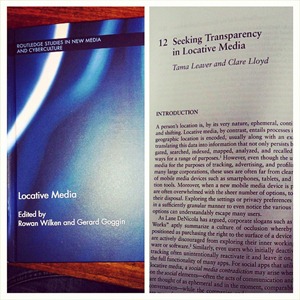 The newly-released edited collection Locative Media by Rowan Wilken and Gerard Goggin features a chapter from Clare Lloyd and me looking at issues of privacy and transparency relating to the data generated, stored and analysed when using mobile and locative-based services. Here’s the abstract:
The newly-released edited collection Locative Media by Rowan Wilken and Gerard Goggin features a chapter from Clare Lloyd and me looking at issues of privacy and transparency relating to the data generated, stored and analysed when using mobile and locative-based services. Here’s the abstract:
A person’s location is, by its very nature, ephemeral, continually changing and shifting. Locative media, by contrast, is created when a device encodes a users’ geographic location, and usually the exact time as well, translating this data into information that not only persists, but can be aggregated, searched, indexed, mapped, analysed and recalled in a variety of ways for a range of purposes However, while the utility of locative media for the purposes of tracking, advertising and profiling is obvious to many large corporations, these uses are far from transparent for many users of mobile media devices such as smartphones, tablets and satellite navigation tools. Moreover, when a new mobile media device is purchased, users are often overwhelmed with the sheer number of options, tools and apps at their disposal. Often, exploring the settings or privacy preferences of a new device in a sufficiently granular manner to even notice the various location-related options simply escapes many new users. Similarly, even those who deactivate geolocation tracking initially often unintentionally reactivate it, and leave it on, in order to use the full functionality of many apps. A significant challenge has thus arisen: how can users be made aware of the potential existence and persistence of their own locative media? This chapter examines a number of tools and approaches which are designed to inform everyday users of the uses, and potential abuses, or locative media; PleaseRobMe, I Can Stalk U, iPhone Tracker and the aptly named Creepy. These awareness-raising tools make visible the operation of certain elements of locative media, such as revealing the existence of geographic coordinates in cameraphone photographs, and making explicit possible misuses of a visible locative media trail. All four are designed as pedagogical tools, aiming to make users aware of the tools they are already using. In an era where locative media devices are easy to use but their ease occludes extremely complex data generation and potential tracking, this chapter argues that these tools are part of a significant step forward in developing public awareness of locative media, and related privacy issues.
A version of the chapter is available at Academia.edu (and just for fun, the book has a 2015 publication date, so at the moment, it’s *from the future*!)

